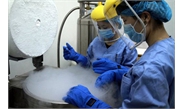Assisted reproduction five-year plan released in Shanghai amid large infertile population

A new born baby in a hospital in China Photo: VCG
Shanghai Municipal Health Commission recently released human assisted reproduction five-year plan to better regulate the market as the potential for assisted reproduction technology is still huge by 2025 depending on the analysis of the residential population, the number of married women of child-bearing age as well as the infertility status in the city.
As an international metropolis, Shanghai's assisted reproduction technology (ART) has attracted many clients at home and abroad, and the demand will further increase, according to Shanghai authorities.
The city will establish a high-level service and management system to build reproductive medicine centers with international competitiveness by 2025, the plan said.
In Shanghai alone, there are 18 medical institutions providing assisted reproduction services, 16 of which are in operation, one in trial operation and another in preparation. Among the 18 institutions, 13 are public ones and the rest are established by the social strength.
Notably, the plan allows the city to establish two human sperm banks, and there will be no more sperm banks built until 2025, according to the plan.
The plan forbids ART to be used for commercial and industrialization purposes, and all the assisted reproduction medical institutions have to insist on working for public welfare.
For institutions newly applied to carry out ART, strict approval process will be required. For those medical institutions which have already provided the ART services, inspections will be launched to examine their technology, quality, safety and ethical standards, while a white list of institutions will be regularly published.
The infertile population in China has reached over 50 million due to the delay of childbearing, environment and pressure, according to media reports.


